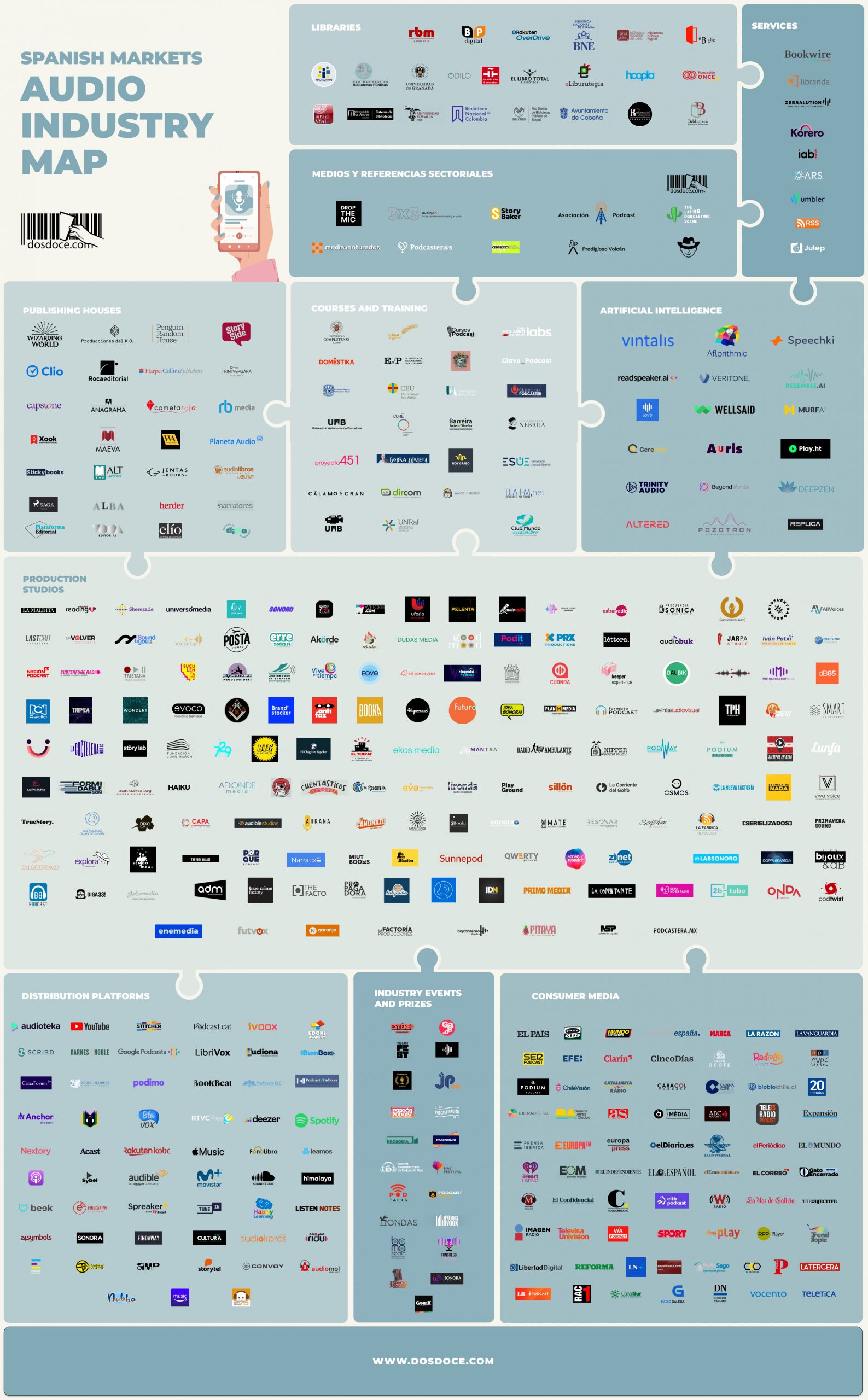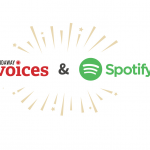More than 400 entities make up the new Spanish Audio Industry Ecosystem
- An industry that will grow to 26.6 million listeners in 2026 and that these will generate revenues of 590 million euros through advertising, branded content, subscription revenues, etc., according to a study by PwC
- The three main economic activities of the audio industry ecosystem in the Spanish-language markets (Spain, Latin America, and the US Hispanic market) are: production studios (36%), media houses producing audio content (18%) and audio entertainment streaming platforms (14%). The rest of the ecosystem is composed by another seven economic activities analyzed, but with a smaller representation. For example, Spanish publishing houses represent less than 7% of the total entities in the audio industry.
- 50% of the players identified come from Spain, while 29% represent entities from various Latin American countries. The remaining 14% of the entities are born in the United States and 7% from Europe.
- One of the main conclusions of this study is the growing international trend driven by the different players in the industry to bet on the production and distribution of wide diversity of audio formats, whether podcasts, audiobooks, audio-series, etc., instead of only betting on just one format.
Madrid, March 23rd, 2023. In just five years, more than 430 entities have firmly committed to the development of the new audio industry in Spanish-language markets (Spain, Latin America, and the US Hispanic market), according to the first “Map of the Spanish Audio Industry Ecosystem” created by Dosdoce.com, a platform specializing in trends in the digital economy. The 430+ entities that represent this new industry have created more than 100,000 podcasts and nearly 25,000 audiobooks in Spanish, among other formats, compared to the scarce audio content in Spanish only a few years ago.
To carry out the first “Map of the Spanish Audio Industry Ecosystem”, Dosdoce.com has conducted extensive research for two months analyzing ten different categories of economic activities related to the world of audio: production studios, streaming platforms, media that are producing audio content, specialized artificial intelligence companies, audio content distribution channels, training entities, publishers, libraries, festivals and events focused on audio, as well as specialized media in the sector.
The three main economic activities of the Spanish Audio Industry Ecosystem are: studios that provide production services (36%), media that producing audio content (18%) and audio streaming platforms (14%) such as Audible, iHeart, Spotify, Storytel, Podimo, etc.
The map is completed by the rest of the ten categories analyzed, but with a lower representation. Spanish and Latin American publishing houses represent less than 7% of the total entities identified in the Audio Industry Ecosystem indicating that very few imprints (less than 25) are producing and distributing Spanish audio.
50% of the entities identified in the industry come Spain, while 29% represent entities from various Latin American countries. The remaining 14% of the entities originate in the United States and 7% from Europe.
An industry that will grow to 26.6 million listeners in 2026 and that these will generate revenues of 590 million euros through advertising, branded content, subscription revenues, etc., according to a study by PwC
Rapid growth of the audio industry in Spain and Latin America
19 million Spaniard over the age of 16 already listen to online audio content monthly: music, live and recorded radio, audiobooks, podcasts, etc. Podcasts is the only format that grew in 2022 compared to 2021 (ten points) and is already consumed by 54% of the audience between 16 and 70 years of age. (Source: IAB Digital 2023)
In this fast-forward listening growth context, the main three activities represented in the Spanish Audio Industry Ecosystem in Spain are: production studios (36%), media that bet on this format (23%), entities dedicated to training related to the audio world (11%) and streaming platforms (7%). The rest of the analyzed entities, with less presence, cover the other categories analyzed in this research.
For its part, Latin America is clearly a major producer of audio content. 50% of the entities identified in Latin America represent production studios, with Argentina, Mexico and Colombia being the countries with the highest representation of entities.
The U.S. Hispanic market
Unlike in Spain, as well as the Latin American markets, there is already strong competition to get the attention of Spanish audio listeners in the United States. Nearly 40% of the entities identified in the United States are apps and streaming platforms that provide spoken word content in Spanish (podcast, audiobooks, audio dramas, etc.)
The future growth of the Spanish-language audio industry depends on enlarging the Hispanic listeners base in the United States, a market of more than 60 million people. The United States is the country with the second largest number of Spanish speakers in the world, after Mexico, which has more than 120 million people.
AI’s breakthrough in the auditing world
It is interesting to note that 4% of the entities identified have specialized in developing technologies and services based on artificial intelligence as the axis of innovation of the future audio industry in Spanish.
“Artificial intelligence (AI) in the world of audio will have more and more weight in the sector every year as it will invade multiple processes of creation, distribution, and marketing, sooner than we suspect. Today, AI is already present in processes such as script correction and translation, but artificial intelligence is reaching creative areas that until now we thought were reserved as intrinsic characteristics of humans: the creation of original content, in other words, podcasts and audiobooks written and narrated by robots”, stated Javier Celaya, founder of Dosdoce.com.
Confluence of audio formats to create an bigger audio industry
One of the main conclusions of this study is the growing international trend driven by the different players in the industry to bet on the production and distribution of wide diversity of audio formats, whether podcasts, audiobooks, audio-series, etc., instead of only betting on just one format.
If we pay attention to what platforms offer their listeners in the USA, we find that 45% focus their catalog on podcasts, another 38% specialize in audiobooks and an emerging 17% offer both podcasts and audiobooks, broadening the spectrum of listeners by offering a greater diversity of audio content that appeals to more audiences.
In Spain and Latin America, the data indicate that there is still a strong imbalance. In Spain, 68% of the organizations are only committed to podcasts, while 19% are only committed to audiobooks. Only 13% of the entities analyzed are indifferently committed to both formats. Whereas in Latin America, the imbalance is even greater given that 81% of the organizations only use podcasts, while 10% only use audiobooks. Only 9% of the organizations surveyed are indifferently committed to both formats.
As more and more organizations are indifferently committed to the creation and commercialization of all types of audio content formats (podcasts, audiobooks, audio dramas, bookcasts, etc.), the Spanish audio industry will grow faster on both sides of the Atlantic. «The Spanish audio industry will grow faster if all players in the sector bet firmly on the development of products and services in multiple audio formats in order to create a global category called ‘audio content'», stated Javier Celaya, founder of Dosdoce.com.
Methodology:
To carry out the first Map of the audio industry in Spanish, the Dosdoce.com team has carried out extensive research for three months, analyzing ten categories of economic activities related to the world of audio: production studios, streaming, media groups that are using this new format to attract new audiences, specialized artificial intelligence companies, audio content distribution channels, training entities, publishers, libraries, festivals and events focused on audio, as well as specialized trade media.
Being a new industry in constant growth, we have no doubt that we have not detected all the entities that are part of it. We invite you to leave us in the comments of this post the names and the URL of those production studios, platforms, festivals, meetings, awards, training entities, etc., that you know or in which you work so that we can add to list.
Our goal is to update this map annually in order to help audio industry professionals better understand its evolution: new players, out-of-business ones, fastest growing categories, industry volume, trends, etc.






